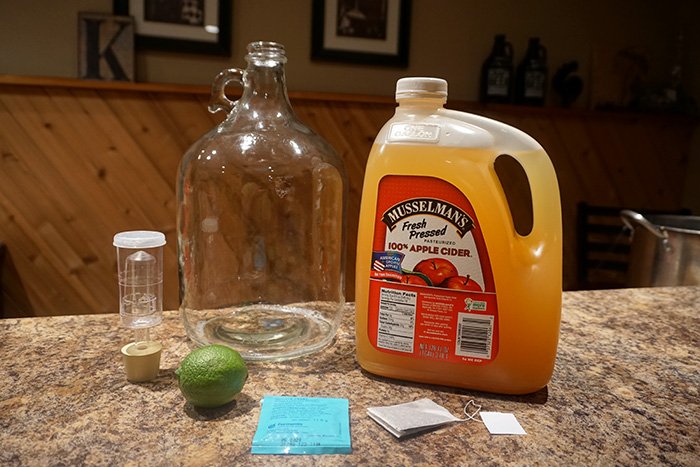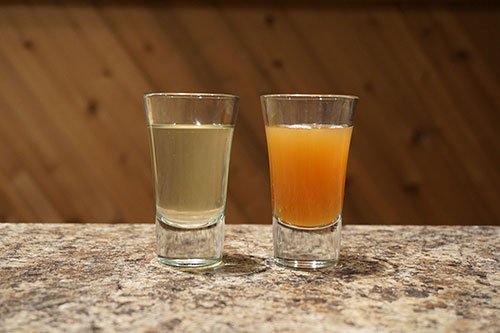Why would you back sweeten hard cider? Unless you added a lot of additional sugar before fermentation, there is a good chance your cider will be dry after fermentation. This leaves the cider a bit tart and maybe seeming a little watery. Back sweetening or adding some sweetness back to the cider will help balance the flavors and restore the apple nature of the cider. This simple process can have big impacts on a cider although there are some important considerations depending on how you will store your cider.

Finding The Right Balance:
The right amount of sweetness for your cider will depend on the batch of cider and personal preference. This will require some testing and experimenting, especially if you want to try different sugars and sweeteners. If you are planning to use nonfermentable sweeteners to back sweeten cider, a hydrometer reading will be useless as they are not calibrated to measure alternative sweeteners; only sugar.
To find the right balance, I like to pour off a few 100ml samples of dry cider and add different measured amounts of sweetener to each. I taste and compare each sample to determine which solution I prefer. Once I know the amount of sweetener per 100ml, I can calculate the equivalent for each bottle or the entire batch.
Back Sweeten Hard Cider for Bottling :
Back sweetening cider that will be bottled (vs kegged) can be a bit tricky for the home cider maker because any fermentable sugar added to the cider will continue fermenting due to active yeast suspended in the cider. Even if the hard cider has been bulk aged for months there can still be dormant yeast waiting to get more sugar! Back sweetening with fermentable sugars and bottling with active yeast can lead to over carbonation and/or possibly bottle bombs!
The safest method as a home cider maker for back sweetening cider, especially one that is naturally bottle carbonated, is to add a non-fermentable sweetener. The ensures that the yeast will only consume the priming sugar for carbonation.
If you are bottling your cider, there are three options that I suggest:
- Non-fermentable sweeteners
- Pasteurization
- Sulfites and preservatives (only for still ciders as no yeast will be alive to produce carbonation)
1. Non-fermentable sweeteners:
The first and most recommended is to use a non-fermentable sweetener. This ensures that fermentation will not start back up and as long as your priming sugar calculations are correct your bottles will be safe. The only downside I find with some of these sweeteners, such as stevia, is that they can impart an aftertaste that may be off-putting when used in higher quantities. Of course, this is all personal preference.
Back sweetening the cider with a non-fermentable sweetener is a simple and safe process. The sweeteners listed below should dissolve easily with a gentle stir.
- Erythritol
- Xylitol
- Stevia
- Splenda
- Lactose
- Maltodextrin
2. Pasteurize your cider after sweetening and carbonating:
The second option is to allow your bottles to carbonate for a period of time and then pasteurize the cider to kill the yeast. Pasteurizing the cider can be risky and heightens the risk of over carbonation and exploding bottles. If you choose to go this route, be extremely careful!
To monitor the level of carbonation fill a plastic soda bottle with the cider at the time of bottling. Set this plastic bottle next to the other cider bottles and check the firmness often. Within a week or two, the bottle should be firm. Open the plastic bottle and check the carbonation. If the cider is not carbonated enough, wait another day or two and open a bottle to check again. When you have reached your desired level of carbonation the bottles are ready to be pasteurized.
How to Pasteurize Bottles of Cider:
One: Fill a sink or container with hot tap water.
Two: Place the bottles of cider into the hot tap water to slowly bring them up to temperature. Preheating will reduce the thermal shock and reduce the risk of bottles breaking.
Three: Fill a brew kettle with water and bring it to about 180F. Turn off the heat and place a canning rack or towel on the bottom of the kettle. This will protect the bottles from bouncing.
Four: Place the prewarmed bottles in the brew kettle and cover with a sturdy lid. This is the most dangerous part of the process. If there is a weak bottle or an already over-carbonated bottle, they may explode. Use proper safety equipment when pasteurizing as flying hot liquid and broken glass are possible!
Five: Keep the bottles submerged in water for approximately 10 minutes so the internal temperature of the bottles reaches approximately 140F-150F.
Once this batch is done, remove the bottles and reheat the water for another batch.
3. Use sulfates and sorbate to stop fermentation of the cider:
If you prefer a still cider or have the equipment to force carbonate then you can back sweeten with whatever you would like as long as you add campden and sorbate to stabilize the cider. Contrary to popular belief this combo will not kill the yeast completely but it will inhibit further fermentation and preserve the cider.
The typical additions for a cider are one tablet of campden (potassium or sodium metabisulfite) and 1/2 tsp of potassium sorbate per gallon. The campden should be added first and allowed 12 hours to rest. Then, the sorbate can be added to the batch to complete the mixture.
Once the cider has stabilized, you will be able to add your back sweetener, such as apple juice concentrate, without the risk of refermentation.
For best practice, back sweeten the batch of cider and monitor for 24 hours before bottling to make sure the sulfites and sorbate additions were adequate.
Additional back sweetening options:
If these Home Cider Making methods are not something that work for you, consider carbonating your cider dry and adding a splash of fresh cider or simple syrup solution while serving.
If you have a kegging setup then you can back sweeten in the keg with any sugar, add CO2 and chill as long as you will consume the cider in a reasonable amount of time. Otherwise, add sulfates as needed.
Cider Makers Note: If you know you will be drinking all of the cider within a week or so, you can place the bottles into a refrigerator without pasteurizing them. The cold temperature will nearly halt yeast activity to provide you with a short window to consume the cider. If you choose to do this, make sure you have a way to identify the bottles and date them to avoid them being misplaced or forgotten. Even in the cold temperatures yeast can still be active and cause the bottles to explode if left for an extended time.








I want to add tart cherry juice. Montmorecy cherry juice. When can I add and how much to one gallon of cider?
Hi Walt,
I would suggest adding the cherry juice after primary fermentation has stopped.
The amount you will want to add depends on several factors such as the apple blend used, current gravity and the desired sweetness finished sweetness. In the end, it comes down to your preference. Add a little bit at a time and sample often until you find something you enjoy.
Note: Even though cherry juice is tart, it has a fair bit of sugar in it so fermentation will restart if the cider is not stabilized first.
Cheers!
Hi.
I’m just wondering.
What is the lowest amount of calories you could make with a 3-4% alcohol percentage?
I’ve found I need to get the suspended yeast completely out of any ciders I make. I’ve sorbated and K-meta. Transfered 3 times and cold crashed. I still find there’s a ton of suspended yeast in there.
My question is will I lose much flavor if I run this thru a Buon Vino Mini Jet Filter will I lose much flavor? And when should I back sweeten if I plan on running it thru the Jet Filter? I’ve found the frozen concentrated AJ works well. But I’m having a really really hard time with the yeast.
Hi Mike,
I find yeast causes stomach issues for me so I like to get as much of it out as possible too.
I haven’t used a filter yet but I am planning to make one and test it out soon. I hear filtration may affect the flavor but the biggest issue is causing oxidation that will make your cider taste like cardboard. So, with proper technique, I think it is worth a shot. Many fine wines are filtered so I would assume a cider would be treated the same.
Cheers,
Curt
Thanks Curt. I just ordered my filter (have to have for my meads as well) so we’ll see. Have read numerous places it REALLY helps with the meads. I have a few gallon batches made already that I’ll try filtering one and see.
I will say that yeast was getting the best of me on a few different levels. Effected my lungs/breathing too. After a little research I cleared myself up with an acidiphilus probiotic and consuming manuka honey on a daily basis. BOOM! Cleared it right up…and quickly. I have some Candida support pills I take too (somewhat like a probiotic).
Still learning what I like with the ciders in terms of back sweetening. So far I’ve found making REALLY dry high ABV cider and backsweetening/diluting with regular apple cider I’ve liked the best. I’m open to any and all suggestions on backsweetening. I’ve tried brown sugar. Honey. Not enamored yet. I’d love to get to an Angry Orchard-type taste honestly.
Have you ever tried using a Soda Stream to carbonate cider? I’ll be bottling this weekend and thought I might try it.
Hi Karen,
I have not tried using a soda stream but I have thought about it in the past. I think it would work, let me know how it goes!
Same process as forced carbonation, so it should work.
I think soda stream should only be used with water. I use drinkmate for my cider. Same principle- CO2 canister, and it works well.
When you use the campden and sorbate, do you use an airlock?
Yes, at this point it is important to keep any contaminates and oxygen out.
Tell me please. During the wild fermentation of cider on day 3 , a foam of about 2 cm was formed . We removed the foam. Do I need to do this or not? I’m afraid that they removed the working yeast with foam
Hi Kristina, that foam is referred to as krausen and is totally normal. Here is an article about it https://www.homecidermaking.com/krausen-formation-cider-during-fermentation/ . A very minimal amount of yeast would have been removed with the foam, nothing to worry about. But, if you removed the sediment from the vessel when you removed the foam, you could have removed a lot of the yeast colony although they should continue to reproduce as long as there is sugar to consume.
HI i made cider in the autum teh taste is taste in quite tart should I throw this ? it is bottled etc. not sure how to recover it?
Add sugar
Do you ever use “Wine Conditioner?”
Hi.
when using the plastic bottle method to check carbonation, can you just place the cider in the refrigerator once it get to the desired carbonation level to slow down or stop the ferment? I don’t want to create bottle bombs, but would like to develop some carbonation at this stage.
thank you
Ive racked my cider 3 times over the last four months and now want to carbonate. I added 1 as of sugar /gal. Do i need to add more yeast or is there some remaining that will work for carbonation?
Thank you